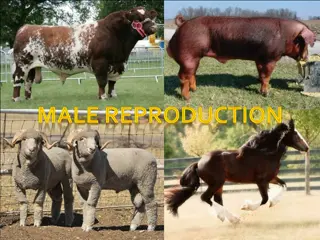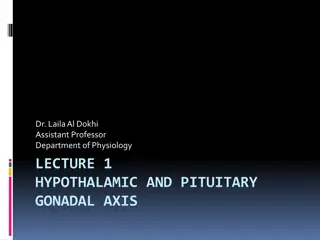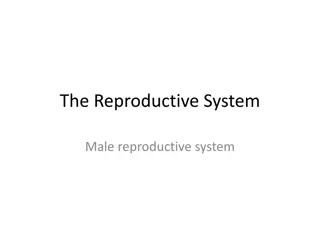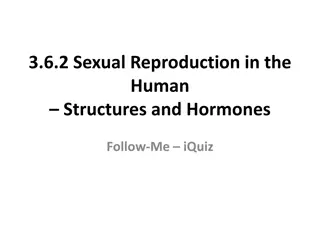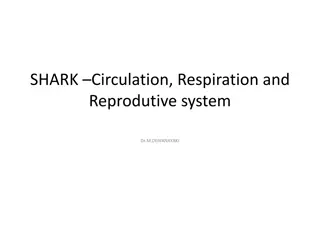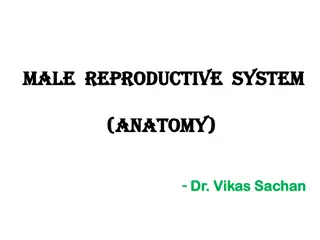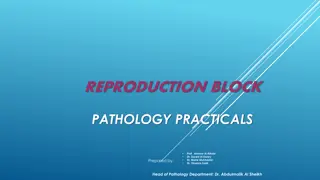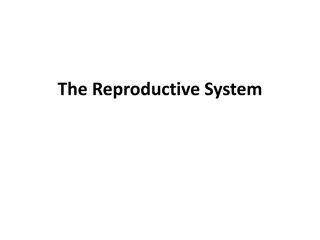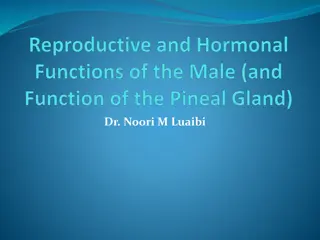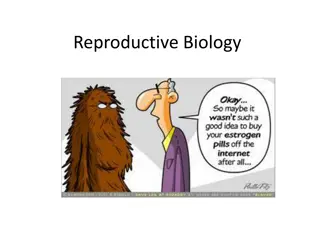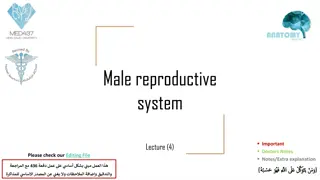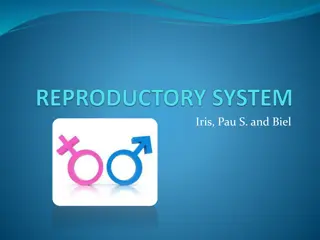Understanding the Male Reproductive System Physiology
The male reproductive system facilitates spermatogenesis, hormone production, and the physiological processes essential for ejaculation and erection. Sperm cells mature in the epididymis before passing through the vas deferens to reach the seminal vesicle, where they are nourished with nutrient-rich fluids. The prostate gland and bulbourethral glands also play crucial roles in enhancing sperm motility and lubrication. Erection is enabled by the influx of blood into the penile tissues, leading to enlargement and stiffness necessary for sexual intercourse.
Download Presentation

Please find below an Image/Link to download the presentation.
The content on the website is provided AS IS for your information and personal use only. It may not be sold, licensed, or shared on other websites without obtaining consent from the author. Download presentation by click this link. If you encounter any issues during the download, it is possible that the publisher has removed the file from their server.
E N D
Presentation Transcript
Human Reproductive System Part 3 October 2021 Dr. Anna Haro Westside HS
LEARNING Objectives TEKS: 130.231.(c)(1)(A, & B) and 130.231.(c)(2)(A, B, C, F, & G) & (3)(B) Students will apply knowledge of the anatomy and physiology of the human reproductive system (RS). Students will explain the physiology of erection and ejaculation. Students will compare pathophysiologies of reproductive system morbidities.
Objetivos de aprendizaje TEKS: 130.231.(c)(1)(A, & B) and 130.231.(c)(2)(A, B, C, F, & G) & (3)(B) . Los estudiantes aplicar n el conocimiento de la anatom a y fisiolog a del sistema reproductivo humano (RS). Los estudiantes explicar n la fisiolog a de la erecci n y la eyaculaci n. Los estudiantes comparar n la fisiopatolog a de las morbilidades reproductivas.
Physiology of the Male Reproductive System The ______________ are responsible for spermatogenesis and the production of male sex hormones. New sperm are immature. Next, in the epididymis, sperm cells are stored and matured, then exit to the vas deferens. The vas deferens moves the mature sperm cells to the seminal vesicle. In the seminal vesicle, an alkaline and nutrient- rich fluid is added to the sperm cells (including fructose and prostaglandins).
Physiology of the Male Reproductive System - continued From the seminal vesicle, the sperm and seminal fluid empty into the ejaculatory ducts to increase the total fluid volume. Next, the prostate gland secretes a thin and milky fluid into the urethra to neutralize the sperm-containing fluid and aids in sperm motility. Just below the prostate, the bulbourethral glands secrete a mucus-like fluid into the urethra in direct response to sexual stimulation which aids in lubrication during intercourse. This fluid is expelled first from the urethra during emission and ejaculation. Note: if erection and ejaculation both do not occur, then fertilization of the egg and hence, ______________ cannot occur.
What is an erection? The penis is specialized to enlarge and stiffen to form an _____________________, allowing penetration of the vagina. The penile anatomy includes erectile tissue, including the pair of corpora cavernosa and the corpus spongiosum which act to increase the supply of blood in the shaft. Sexual stimulation activates parasympathetic nerve impulses from the sacral region of the spinal cord releasing nitric oxide, a potent vasodilator (note: this is used in tx of AMI), to cause rush of blood into the penile arteries and specialized tissues. Simultaneously, the increased pressure of excess arterial blood compresses the veins and ________ blood flow out of the penis. The penis both swells and elongates during an erection.
What is ejaculation? While erect, if the penis receives pleasurable stimulation, this causes sympathetic nerve impulses from the spinal cord to coordinate peristaltic contractions in the testicular duct, epididymis, vas deferens, ejaculatory duct hence moving the sperm and seminal fluid into the urethra. Simultaneously, the nerves stimulate contraction and movement of the seminal vesicles and prostate gland. In response, motor nerve impulses are transmitted to skeletal muscles at the root of the penis causing rhythmic contractions of the erectile tissue within the penis shaft. The pressure continues to rise as the sperm and seminal fluid are forced through the urethra and to the outside of the body during the climax, or __________. The orgasm generates intense and pleasurable feelings of physiological and psychological release. What NT s are stimulated in the CNS?
Reproductive pathophysiology (male RS) Erectile dysfunction, the inability to get and keep an erection firm enough for intercourse. Peyronie's disease, a chronic condition that involves the development of abnormal scar tissue inside the penis, often resulting in bent or painful erections. Ejaculation problems, including the inability to ejaculate, premature ejaculation, delayed ejaculation, painful ejaculation, reduced ejaculation or retrograde ejaculation, when semen enters the bladder instead of emerging through the penis. Penile fracture, rupture during an erection of the fibrous, tubelike tissue in the penis, usually caused by an erect penis forcefully striking the female pelvis during sex. Anorgasmia, the inability to achieve an orgasm despite adequate stimulation. Priapism, a persistent and painful erection that isn't caused by sexual stimulation or arousal. Decreased libido, a reduced desire for ______. Phimosis, a condition in which the foreskin of an uncircumcised penis can't be retracted from the penis head, causing painful urination and erections. Sexually transmitted infections or STI/STD including genital warts, gonorrhea, chlamydia, syphilis and genital herpes that can cause painful urination, penis discharge, and sores or blisters on the penis or in the genital area. More about this on Friday!!! Paraphimosis, a condition in which the foreskin can't be returned to its normal position after being retracted, causing painful swelling of the penis and impaired blood flow. Yeast infection, inflammation of the head of the penis (balanitis), a reddish rash, white patches on the penis, itching or burning, and a white discharge. Penile cancer, begin as a blister on the penis and becomes wartlike growth, discharging watery pus.
Reproductive pathophysiology (female RS) Low sexual desire. This most common of female sexual dysfunctions involves a lack of sexual interest and willingness to be sexual. Causes of infertility: Ovulation disorders Damage to fallopian tubes (tubal infertility) Sexual arousal disorder. Your desire for sex might be intact, but you have difficulty with arousal or are unable to become aroused or maintain arousal during sexual activity. Endometriosis Uterine or cervical causes Unexplained infertility: In some cases, the cause of infertility is never found. A combination of several minor factors in both partners could cause unexplained fertility problems. Although it's frustrating to get no specific answer, this problem can correct itself with time. But you shouldn't delay treatment for infertility. Orgasmic disorder. You have persistent or recurrent difficulty in achieving orgasm after sufficient sexual arousal and ongoing stimulation. Sexual pain disorder. You have pain associated with sexual stimulation or vaginal contact. More info is found at this direct link: https://www.mayoclinic.org/diseases- conditions/female-infertility/symptoms- causes/syc-20354308 STDs (more info on Friday) Infertility. The inability to conceive and or to bear live offspring.
What are your questions about the male reproductive system or about your research papers? Please ask, email, use Remind, or TEAMS. Remember the HON-code? https://www.hon.ch/HONcode/. Even if you cannot find the HON-code stamp, please use the principles of website evaluation. Authority, confidentiality, complementary, attribution, justification, transparency, financial disclosure, and advertising policy (HON-code, 2019).
References https://my.clevelandclinic.org/health/articles/9117-male-reproductive-system Shier, D., Butler, J., Lewis, R., & Hole, J. W. (2002). Hole's Human Anatomy and Physiology (9th ed.). McGraw-Hill. https://www.mayoclinic.org/healthy-lifestyle/mens-health/in-depth/penis-health/art-20046175 https://www.mayoclinic.org/diseases-conditions/female-sexual-dysfunction/symptoms-causes/syc-20372549 https://www.urccp.org/index.cfm?Page=Home https://www.urccp.org/article.cfm?ArticleNumber=50








